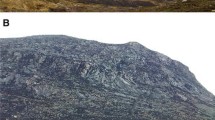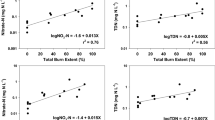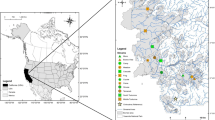Abstract
The Angora Fire (summer of 2007) was the largest and most severe wildfire in recent history within the Lake Tahoe basin of the Sierra Nevada. To determine the watershed response and to assess the potential for downstream impacts of nutrient and sediment delivery to Lake Tahoe, we monitored the post-fire hydrology and stream water chemistry for 2 years at four locations along the length of Angora Creek, a perennial stream draining the burned watershed. When compared with unburned streams, the hydrology of Angora Creek indicated an earlier and faster melting of the spring snowpack. Peak stream water concentrations of total N (TN) and ammonium occurred within the burned area, whereas peak concentrations of nitrate (NO3 −), total P, soluble reactive P, total suspended solids, turbidity, electrical conductivity (EC), and dissolved organic C occurred below the burned area. In comparison to pre-fire data, TN, NO3 −, TP, total dissolved P, EC, and turbidity increased following the fire, particularly in the wetter second year. Yields for subwatershed areas suggest that the burned urban subwatershed was the largest source of nutrients and sediments, whereas the wet meadow subwatershed downstream of the burned area retained materials. Erosion control efforts, below-average annual precipitation and the timing of its arrival (absence of summer and fall rainstorms), and the existence of a wet meadow below the burned watershed likely reduced the negative impacts that would have been expected from such a severe wildfire.








Similar content being viewed by others
References
Andersen HE (2004) Hydrology and nitrogen balance of a seasonally inundated Danish floodplain wetland. Hydrol Process 18:415–434
Biggio ER, Cannon SH (2001) Compilation of post-wildfire runoff data from the Western United States. http://www.fs.fed.us/rm/pubs/rmrs_gtr042_4.pdf. Accessed 30 Nov 2010
Bladon KD, Silins U, Wagner MJ, Stone M, Emelko MB, Devito KJ, Mendoza CA, Boon S (2008) Wildfire impacts on nitrogen export and production from headwater streams in southern Alberta’s Rocky Mountains. Can J For Res 38:2359–2371
Bradstock RA, Hammill KA, Collins L, Price O (2010) Effects of weather, fuel and terrain on fire severity in topographically diverse landscapes of south-eastern Australia. Landscape Ecol 25:607–619
Brooks KN, Ffolliott PF, Gregersen HM, Debano LF (2003) Hydrology and the management of watersheds, 3rd edn. Iowa State University Press, Ames
Carroll EM, Miller WW, Johnson DW, Saito LS, Qualls RG, Walker RF (2007) Spatial analysis of a large magnitude erosion event following a Sierran Wildfire. J Environ Qual 36:1105–1111
Chorover J, Vitousek PM, Everson DA, Esperanza AM, Turner D (1994) Solution chemistry profiles of mixed-conifer forests before and after fire. Biogeochemistry 26:115–144
Clesceri LS, Greenberg LA, Eaton AD (1998) Standard methods for the examination of water and wastewater, 20th edn. APHA, AWWA
Coats RN, Liu F, Goldman CR (2002) A Monte Carlo test of load calculation methods, Lake Tahoe Basin, California-Nevada. J Am Water Res Assoc 38:719–730
Coats RN, Larsen M, Heyvaert AC, Thomas J, Luck M, Reuter JE (2008) Nutrient and sediment production, watershed characteristics and land use in the Tahoe basin, California-Nevada. J Am Water Res Assoc 44:754–770
DeBano LF, Rice RM, Conrad E (1979) Soil heating in chaparral fires: effects on soil properties, plant nutrients, erosion and runoff. USDA-FS Res. Pap. PSW-145. Pacific Southwest Forest and Range Experiment Station, Berkeley
Doane TA, Horwath WR (2003) Spectrophotometric determination of nitrate with a single reagent. Anal Lett 36:2713–2722
Earl SR, Blinn DW (2003) Effects of wildfire ash on water chemistry and biota in south-western USA streams. Freshw Biol 48:1015–1030
Ferguson RI (1987) Accuracy and precision of methods for estimating river loads. Earth Surf Process 12:95–104
Fishman MJ, Friedman LC (1985) Methods for the Determination of Inorganic Substances in Water and Fluvial Sediments. USGS Open-File Report 85-495. http://pubs.usgs.gov/twri/twri5-a1/. Accessed 30 Nov 2010
Forster JC (1995) Soil nitrogen. In: Alef K, Nannipieri P (eds) Methods in applied soil microbiology and biochemistry. Academic Press, New York, pp 79–87
Fried JS, Torn MS, Mills E (2004) The impact of climate change on wildfire severity: a regional forecast for Northern California. Clim Change 64:169–191
Goldman CR, Jassby AD, de Amezaga E (1990) Forest fires, atmospheric deposition, primary production at Lake Tahoe, California-Nevada. Verh Int Ver Limnol 24:499–503
Hall SJ, Lobardozzi D (2008) Short-term effects of wildfire on montane stream ecosystems in the southern Rocky Mountains: one and two years post-burn. Western N Am Nat 68:453–462
Hauer FR, Spencer CN (1998) Phosphorus and nitrogen dynamics in streams associated with wildfire: a study of immediate and longterm effects. Int J Wildl Fire 8:183–198
Hazelhurst S, Heller S, Green M (2001) Angora Creek Water Quality Monitoring Report: 1991–2000. USDA-FS. Lake Tahoe Basin Mgt Unit, South Lake Tahoe
Helvey JD, Tiedemann AR, Anderson TD (1985) Nutrient loss by soil erosion and mass movement after wildfire. J Soil Water Conserv 40:168–173
Heyvaert AC (1998) The biogeochemistry and paleolimnology of sediments from Lake Tahoe, California-Nevada. Dissertation, University of California
Jassby AD, Goldman CR, Powell TM (1992) Trend, seasonality, cycle, and irregular fluctuations in primary productivity at Lake Tahoe, California-Nevada, USA. Hydrobiologia 246:195–203
Johnson EA, Miyanishi K (eds) (2001) Forest fires: behavior and ecological effects. Academic Press, San Diego
Johnson DW, Miller WW, Susfalk RB, Murphy JD, Dahlgren RA, Glass DW (2009) Biogeochemical cycling in forest soils of the eastern Sierra Nevada Mountains, USA. For Ecol Manage 258:2249–2260
Kamphake LJ, Hannah SA, Cohen JM (1967) Automated analysis for nitrate by hydrazine reduction. Water Res 1:205–216
Kuusemets V, Mander U (1999) Ecotechnological measures to control nutrient losses from catchments. Water Sci Technol 40:195–202
Lane PNJ, Sheridan GJ, Noske PJ (2006) Changes in sediment loads and discharge from small mountain catchments following wildfire in south eastern Australia. J Hydrol 331:495–510
Leonard RL, Kaplan LA, Elder JF, Coats RN, Goldman CR (1979) Nutrient transport in surface runoff from a subalpine watershed, Lake Tahoe basin. Calif Ecol Monogr 49:281–310
Liddicoat MI, Tibbits S, Butler EI (1975) The determination of ammonia in seawater. Limnol Oceanogr 20:131–132
Likens GE, Bormann FH, Johnson NM, Fisher DW, Pierce RS (1970) Effects of forest cutting and herbicide treatment on nutrient budgets in the Hubbard Brook watershed-ecosystem. Ecol Monogr 40:23–47
McEachern P, Prepas EE, Gibson JJ, Dinsmore WP (2000) Forest fire induced impacts on phosphorus, nitrogen, and cholorophyll-a concentrations in boreal subarctic lakes of northern Alberta. Can J Fish Aquat Sci 57:73–81
McKelvey KS, Skinner CN, Chang C, Erman DS, Husari SJ, Parsons DJ, van Wagtendonk JW, Weatherspoon CP (1996) An Overview of fire in the Sierra Nevada. Sierra Nevada Ecosystem Project: Final report to Congress, vol. II. Center for Water and Wildland Resource, University of California
Miller JD, Safford HD (2008) Sierra Nevada fire severity monitoring 1984–2004. USDA-FS Publication R5-TP-027, Pacific Southwest Region, Vallejo, CA
Miller WW, Johnson DW, Loupe TM, Sedinger JS, Carroll EM, Murphy JD, Walker RF, Glass D (2006) Nutrients flow from runoff at burned forest site in Lake Tahoe Basin. Calif Agric 60:65–71
Miller JD, Safford HD, Crimmins M, Thode AE (2009) Quantitative evidence for increasing forest fire severity in the Sierra Nevada and southern Cascade Mountains, California and Nevada, USA. Ecosystems 12:16–32
Minshall GW, Robinson CT, Lawrence DE (1997) Postfire reponse of lotic ecosystems in Yellowstone National Park, USA. Can J Fish Aquat Sci 54:2509–2525
Moreno-Mateos D, Mander U, Comín FA, Pedrocchi C, Uuemaa E (2008) Relationships between landscape pattern, wetland characteristics, and water quality in agricultural catchments. J Environ Qual 37:2170–2180
Murphy JD, Johnson DW, Miller WW, Walker RF, Blank RR (2006a) Prescribed fire effects on forest floor and soil nutrients in a Sierra Nevada forest. Soil Sci 171:181–199
Murphy JD, Johnson DW, Miller WW, Walker RF, Carroll EF, Blank RR (2006b) Wildfire effects on soil nutrients and leaching in a Tahoe basin watershed. J Environ Qual 35:479–489
Murphy K, Rich T, Sexton T (2007) An assessment of fuel treatment effects on fire behavior, suppression effectiveness, and structure ignition on the Angora Fire. Report R5-TP-025, USDA Forest Service. Pacific Southwest Region, Vallejo
Prepas EE, Burke JM, Chanasyk DS, Smith DW, Putz G, Gabos S, Chen W, Millions D, Serediak M (2003) Impact of wildfire on discharge and phosphorus export from the Sakwatamau watershed in the Swan Hills, Alberta, during the first two years. J Environ Eng Sci 2:S63–S72
Preston SD, Bierman VJ, Silliman SE (1989) An evaluation of methods for the estimation of tributary mass loads. Water Resour Res 25:1379–1389
Puckett M (2002) Quality Assurance Management Plan for the State of California’s Surface Water Ambient Monitoring Program. http://www.swrcb.ca.gov/water_issues/programs/swamp/tools.shtml. Accessed 30 Nov 2010
Ranalli AJ (2004) A summary of the scientific literature on the effects of fire on the concentration of nutrients in surface waters. USGS Open-File Report 2004-1296
Raumann CG, Cablk ME (2008) Change in the forested and developed landscape of the Lake Tahoe basin, California and Nevada, USA, 1940–2002. For Ecol Manag 255:3424–3439
Reuter JE, Cahill TA, Cliff SS, Goldman CR, Heyvaert AC, Jassby AD, Lindstrom S, Rizzo DM (2003) An integrated watershed approach to studying ecosystem health at Lake Tahoe, CA-NV. In: Rapport et al (eds) Managing for healthy ecosystems. CRC Press, New York, pp 1283–1298
Reuter JE, Thomas J, Heyvaert AC (2009) Water Quality. In: Hymanson ZP et al (eds) An integrated science plan for the Lake Tahoe basin: conceptual framework and research strategies. USDA Gen. Tech. Report. PSW-GTR-226. Pacific Southwest Research Station, Albany, pp 83–182
Riggan PJ, Lockwood RN, Jacks PM, Colver CG, Weirich F, DeBano LF, Brass IA (1994) Effects of fire severity on nitrate mobilization in watersheds subject to chronic atmospheric deposition. Environ Sci Technol 28:369–375
Rowe TG, Saleh DK, Watkins SA, Kratzer CR (2002) Streamflow and water quality data for selected watersheds in the Lake Tahoe basin, California and Nevada, through September 1998. http://pubs.usgs.gov/wri/wri024030/. Accessed 30 Nov 2010
Safford HD, Schmidt DA, Carlson CH (2009) Effects of fuel treatments on fire severity in an area of wildland-urban interface, Angora Fire, Lake Tahoe Basin, California. For Ecol Manag 258:773–787
Smith HG, Sheridan GJ, Lane PN, Nyman P, Haydon S (2011) Wildfire effects on water quality in forest catchments: a review with implications for water supply. J Hydrol 396:170–192
StataCorp (2009) Stata software version 11.1. StataCorp, College Station
Stephens SL, Meixner T, Poth M, McGurk B, Payne D (2004) Prescribed fire, soils, and stream water chemistry in a watershed in the Lake Tahoe Basin, California. Int J Wildl Fire 13:27–35
Stubblefield AP, Reuter JE, Dahlgren RA, Goldman CR (2007) Use of turbidiometry to characterize suspended sediment and phosphorus fluxes in the Lake Tahoe basin, California, USA. Hydrol Process 21:281–291
Stubblefield AP, Reuter JE, Goldman CR (2009) Sediment budget for subalpine watersheds, Lake Tahoe California, USA. Catena 76:163–172
Tiedemann AR, Helvey JD, Anderson TD (1978) Stream chemistry and watershed nutrient economy following wildfire and fertilization in eastern Washington. J Environ Qual 7:580–588
USFS (2007) Angora Incident Initial BAER Report. Lake Tahoe Basin Management Unit, South Lake Tahoe, CA. http://www.fs.usda.gov. Accessed 30 Nov 2010
Vitousek PM, Melillo JM (1979) Nitrate losses from disturbed forests: patterns and mechanisms. For Sci 25:605–619
Weaver R, Biddinger T, Rust B (1997) Angora fire burned area assessment, hydrology and soil resource assessment. http://www.fs.usda.gov. Accessed 30 Nov 2010
Westerling AL, Hidalgo HG, Cayan DR, Swetnam TW (2006) Warming and earlier spring increase western US forest wildfire activity. Science 313:940–943
Zhong C (2006) Effects of fire on major forest ecosystem processes: an overview. Ying Yong Sheng Tai Xue Bao 17:1726–1732
Acknowledgments
We would like to thank the United States Geological Survey (USGS) in Carson City, NV for their collaboration and assistance in water quality monitoring. Angora Creek samples were collected as part of the Angora Wildfire Water Quality Monitoring Project, supported by grants to DRI and UCD by the California State Water Board, the US Forest Service Lake Tahoe Basin Management Unit, and the Lahontan Regional Water Quality Control Board. This project was further supported through the Kearney Soil Science Foundation, UCD GGE Block Grants, and the Jastro Shields Fellowship. We thank Todd Mihevc of DRI, Raph Townsend, Andrea Buxton, Collin Strasenburgh, and Xien Wang from UC Davis for their assistance in sample collection and processing.
Author information
Authors and Affiliations
Corresponding author
Rights and permissions
About this article
Cite this article
Oliver, A.A., Reuter, J.E., Heyvaert, A.C. et al. Water quality response to the Angora Fire, Lake Tahoe, California. Biogeochemistry 111, 361–376 (2012). https://doi.org/10.1007/s10533-011-9657-0
Received:
Accepted:
Published:
Issue Date:
DOI: https://doi.org/10.1007/s10533-011-9657-0




